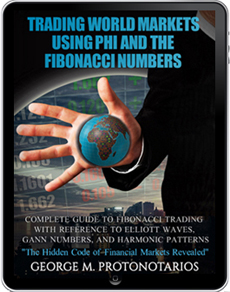
Trading with Fibonacci Mathematics
Fibonacci mathematics can help traders uncover the hidden proportionality in market behavior. Fibonacci extension analysis examines the extent of primary trends and countertrends to identify key reversal zones—levels where a trending market may lose momentum and reverse. » Fibonacci Sequence and Phi
Calculating the Basic Ratios Using the Fibonacci Sequence
The Fibonacci sequence begins as follows: 0, 1, 2, 3, 5, 8, 13, 21, 34, 55, 89, 144, 233, etc. This sequence can be broken down into ratios. These Fibonacci ratios are derived by dividing one number in the sequence by another.
Excluding the initial numbers, we observe that:
✅ Every number is approximately 1.618 times the preceding number.
✅ Every number is approximately 0.618 of the number that follows it.
Note that 1.618 is known as the golden ratio, and its inverse is 0.618.
Key Ratios for Financial Trading
In financial trading, the key Fibonacci ratios are 0.236, 0.382, 0.618, 1.618, 2.618, and 4.236. Many traders also use 0.5 and 1.0.
Table: Key Fibonacci Ratios for Financial Trading
|
0.236 |
1.000 |
|
0.382 |
1.618 |
|
0.500 |
2.618 |
|
0.618 |
3.618 |
|
0.786 |
4.236 |
The Fibonacci sequence produces useful trading tools such as Fibonacci Retracement and Fibonacci Extensions.
Fibonacci Extensions
Fibonacci extensions can help identify the extent of primary trends and countertrends to pinpoint potential price reversal zones. Let's begin by calculating Fibonacci extensions above 100%.
Calculating Fibonacci Extensions Above 100%
These are some basic calculations, as shown in the following table:
- A, the Fibonacci sequence
- A1, dividing each Fibonacci number by the prior number (1 position), and the ratio approaches 1.618
- A2, dividing each Fibonacci number by two places to the left (2 positions), and the ratio approaches 2.618
- A3, dividing each Fibonacci number by three places to the left (3 positions), and the ratio approaches 4.236
Table: Calculating Fibonacci Ratios
|
A |
A1 |
A2 |
A3 |
|
1 |
|||
|
2 |
2.000 (2/1) |
|
|
|
3 |
1.500 (3/2) |
3.000 (3/1) |
|
|
5 |
1.667 (5/3) |
2.500 (5/2) |
5.000 (5/1) |
|
8 |
1.600 (8/5) |
2.667 (8/3) |
4.000 (8/2) |
|
13 |
1.625 (13/8) |
2.600 (13/5) |
4.333 (13/3) |
|
21 |
1.615 |
2.625 |
4.200 |
|
34 |
1.619 |
2.615 |
4.250 |
|
55 |
1.618 |
2.619 |
4.231 |
|
89 |
1.618 |
2.618 |
4.238 |
|
144 |
1.618 |
2.618 |
4.235 |
|
233 |
1.618 |
2.618 |
4.236 |
|
377 |
1.618 |
2.618 |
4.236 |
By adding 3.618 (2.618+1), the key Fibonacci extensions (above 100) are 161.8%, 261.8%, 361.8%, and 423.6%.
Usage
Extension levels are areas where price is expected to reverse. Trend-Based Fibonacci Extensions (TBFEs) can be drawn on any chart and operate using Fibonacci ratios. In bull markets, the Fibonacci Extensions tool is particularly useful for identifying strong resistance when an asset is in price discovery. However, the tool is also applicable in bearish markets. The Fibonacci Extensions tool can serve several purposes:
-
Evaluating how far primary uptrends and downtrends may extend.
-
Setting effective targets for orders (take-profit and stop-loss), especially during price discovery.
-
Analyzing price corrections and distinguishing between temporary pullbacks and key trend reversals.
-
Interpreting crowd behavior during strong bullish movements when other technical tools are ineffective.
How to Draw the Fibonacci Levels
Fibonacci Extensions are drawn using three (3) points, unlike Fibonacci Retracements, which require only two (2). The first step is to identify a trend that will serve as the base.
To draw the Trend-Based Fibonacci Extensions in a bullish trend, click on three specific price levels: the start and end of the primary trend, followed by the end of the secondary trend. In a bearish trend, the same logic applies, but in reverse.
-
Click 1: Click on the beginning of the price movement
-
Click 2: Click on the end of the price movement
-
Click 3: Click on the end of the secondary trend (the retracement against the main move)
In the following chart, the Trend-Based Fibonacci Extension (TBFE) is applied to Ethereum/USD.
Chart: Trend-Based Fibonacci Extension Tool on Ethereum (TradingView)

Trading with Fibonacci Extensions
Fibonacci Extensions operate on the same principles as Fibonacci Retracements, with both tools indicating potential trend reversal levels. The key difference is that Fibonacci Extensions analyze trends extending beyond the base trend, meaning price moves above the 100% level. This is common for newly listed assets with limited historical data or for assets in price discovery following a major fundamental shift.
Fibonacci Extensions can signal entry points when the price bounces off an extension level or provide take-profit targets:
-
Use Fibonacci extension levels as support and resistance zones.
-
Trade in the direction of the trend when price breaks above a Fibonacci extension level, and take profits near the next extension level.
-
Trade a trend reversal after the price bounces off an extension level.
-
Set take-profit zones near Fibonacci extension levels, especially during price discovery.
-
Place stop-loss orders near the next Fibonacci extension level.
Key Takeaways
✅ Fibonacci Extensions follow the same logic as Fibonacci Retracements but analyze price movements beyond the 100% level.
✅ The main extension levels above 100% are 161.8%, 261.8%, 361.8%, and 423.6%.
✅ In bullish trends, the Fibonacci Extensions tool is particularly useful for identifying strong resistance during price discovery.
✅ Trend-Based Fibonacci Extensions (TBFEs) are drawn using Fibonacci ratios and can be applied to any chart.
✅ Drawing Fibonacci Extensions requires a trend and two swing points.
✅ Extension levels mark zones where a trend may reverse.
✅ Fibonacci Extensions can be used to set price targets, with profit-taking orders spread across various extension levels.
✅ Use multiple orders based on Fibonacci Extensions, but remember they indicate zones of support/resistance, not exact points.
✅ False signals are always possible.
✅ It is preferable to apply the Fibonacci Extensions tool on higher timeframes and wait for a confirmed closing price.
✅ Fibonacci Extensions should be used alongside another indicator or a continuation/reversal pattern on a higher timeframe.
■ Introduction to Fibonacci Extensions
G.P. for TradingFibonacci.com (c)
▶️ FIND OUT MORE AT TRADINGFIBONACCI.COM












